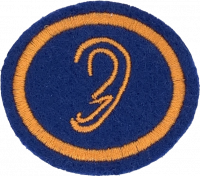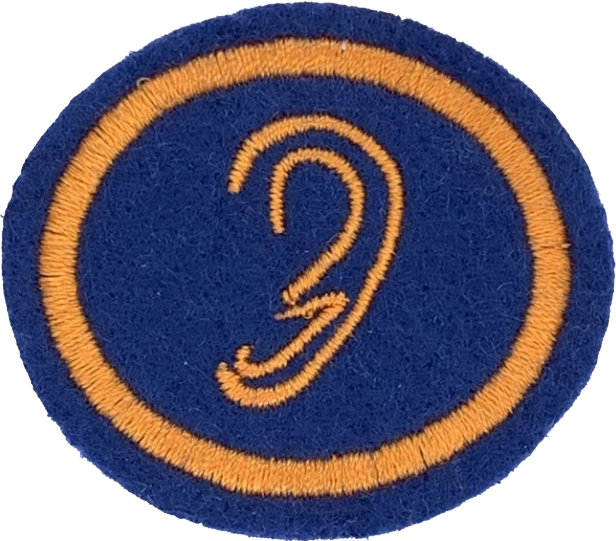Difference between revisions of "AY Honors/Hearing/Requirements/es"
(Updating to match new version of source page) |
(Created page with "Necesitará: Envoltura de plástico (film transparente), recipiente con abertura ancha, arroz crudo (o cualquier otro grano pequeño), bandeja para hornear de hojalata. Esta a...") |
||
| Line 12: | Line 12: | ||
HACER UN MODELO DEL TÍMPANO (También conocido como membrana timpánica) | HACER UN MODELO DEL TÍMPANO (También conocido como membrana timpánica) | ||
| − | + | Necesitará: Envoltura de plástico (film transparente), recipiente con abertura ancha, arroz crudo (o cualquier otro grano pequeño), bandeja para hornear de hojalata. Esta actividad te ayudará a comprender cómo viaja el sonido por el aire. Simplemente estire el trozo de plástico sobre el recipiente o la olla grande. Asegúrese de que la envoltura de plástico esté bien estirada sobre el recipiente. El plástico representa el tímpano. Coloque alrededor de 20-30 granos de arroz crudo o granos sobre la envoltura de plástico. Ahora necesita un generador de ruido, una bandeja para hornear de hojalata funciona bien. Sostenga la bandeja cerca de la hoja de plástico para crear un gran ruido y observe cómo saltan los granos de arroz. El ruido produce ondas sonoras (cambios en la presión del aire) que hacen que la lámina de plástico vibre, lo que hace que los granos de arroz se muevan. Las ondas sonoras hacen vibrar el tímpano en gran parte del mismo camino. | |
| − | + | <noinclude></noinclude><section end=req2 /></b> | |
| − | <noinclude | ||
| − | |||
<section end=challenge /> | <section end=challenge /> | ||
| − | <b>3. <section begin=req3 /><noinclude> | + | <b>3. <section begin=req3 /><noinclude></noinclude>¿Qué son los «huesecillos auditivos»? Nombrar sus partes. |
| − | </noinclude> | + | <noinclude></noinclude><section end=req3 /></b> |
| − | <noinclude | ||
| − | |||
| − | <b>4. <section begin=req4 /><noinclude> | + | <b>4. <section begin=req4 /><noinclude></noinclude>¿Cuál es la función del oído medio? |
| − | </noinclude> | + | <noinclude></noinclude><section end=req4 /></b> |
| − | <noinclude | ||
| − | |||
<b>5. <section begin=req5 /><noinclude><div lang="en" dir="ltr" class="mw-content-ltr"> | <b>5. <section begin=req5 /><noinclude><div lang="en" dir="ltr" class="mw-content-ltr"> | ||
Revision as of 03:48, 19 May 2021
1. ¿Cuántas partes del oído externo hay? ¿Cómo funcionan?
2. Actividad 1: Hacer un modelo del tímpano (también conocido como membrana timpánica).
Asegúrese de grabar su producto terminado en cámara.
HACER UN MODELO DEL TÍMPANO (También conocido como membrana timpánica)
Necesitará: Envoltura de plástico (film transparente), recipiente con abertura ancha, arroz crudo (o cualquier otro grano pequeño), bandeja para hornear de hojalata. Esta actividad te ayudará a comprender cómo viaja el sonido por el aire. Simplemente estire el trozo de plástico sobre el recipiente o la olla grande. Asegúrese de que la envoltura de plástico esté bien estirada sobre el recipiente. El plástico representa el tímpano. Coloque alrededor de 20-30 granos de arroz crudo o granos sobre la envoltura de plástico. Ahora necesita un generador de ruido, una bandeja para hornear de hojalata funciona bien. Sostenga la bandeja cerca de la hoja de plástico para crear un gran ruido y observe cómo saltan los granos de arroz. El ruido produce ondas sonoras (cambios en la presión del aire) que hacen que la lámina de plástico vibre, lo que hace que los granos de arroz se muevan. Las ondas sonoras hacen vibrar el tímpano en gran parte del mismo camino.
3. ¿Qué son los «huesecillos auditivos»? Nombrar sus partes.
4. ¿Cuál es la función del oído medio?
5.Is the Eustachian tube a part of the middle ear? What is its function?
Which is true about the inner ear and balance?
a. The semi-circular canals detect linear motion
b. The utricle and saccule detect linear motion
c. The cochlea detects linear motion
d. The utricle and saccule detect rotary motion
Select the statements which are TRUE for the Cochlea.
a. It is found in the outer ear
b. It makes vibrations
c. It turns vibrations into electrical signals
d. Signals are sent from the cochlea to the auditory nerve
e. C and D
Mention the steps to good ear hygiene.
What are some ways which can help you to protect your ear from damage or hearing loss?
Why is hearing very important in life? Do humans hear better or worse as they get older?
Activity 2 – Measuring sound distances.
Be sure to record your results on the worksheet.
You will need: Tape measure/metre stick, piece of paper, pen/pencil, a field/open area.
How to play: One person stands at one end of an open area (preferably outside) and someone else calls out a word (do not shout) and, gets further and further away until the other person cannot hear the word anymore. Count how many metres the person was placed away from the other person until they could not hear anymore. Write down the score on a piece of paper and, do it for every member of the family then, at the end see who has better hearing.
Select all the statements which apply to a ‘sound source’.
a. An object vibrates
b. Vibrations vibrate air particles
c. The brain
d. A drum
e. A, B and D
f. A, C and D
What is a sound wave caused by?
a. A moving flow of Electrons
b. Pitch
c. Volume
d. Vibration of air particles
e. All the above
f. A and C
Activity 3 – Observing differences in sounds.
Write down your observations below, explaining the differences in the sound.
You will need: Pencil and paper.
Collect all things you have at home which can help you to differentiate sounds. Example, a glass of water. Take 3 glasses of water, put water in one at a low level, one at the middle and a full glass of water. Take a spoon or anything which can help you to hear the sound from each glass and tap the side of each glass. Observe the differences in the sound that comes off the glass.
| Glass | Level of water | What does it sounds like? |
| 1 | Low | |
|---|---|---|
| 2 | Half-full | |
| 3 | Full |
Find at least four Bible texts that specifically mention hearing or the ear.
Summarize in your own words one Biblical story that refers to the sense of hearing.



